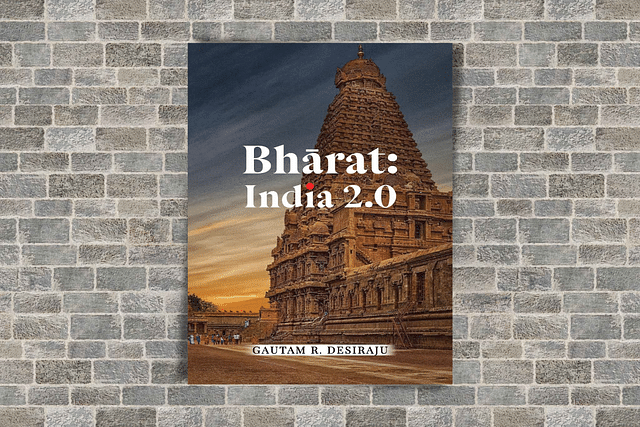Books
'Bharat: India 2.0' Review: A Treatise On Bridging The Divide Between India's Modern State And Ancient Civilisation
- The book 'Bhārat: India 2.0' is a scientist's look at the evolution of the modern Indian state and the ancient Bharatiya nation.

Cover of the book 'Bhārat: India 2.0' by Gautam R Desiraju
Bhārat: India 2.0. Gautam R Desiraju. Vitasta Publishing. 2022. Pages 396. Rs 750.
Jawaharlal Nehru, the first prime minister of India (or the second, if one counts Subhas Chandra Bose) often emphasised the borrowed Russellian term 'scientific temper'.
Out of its Christendom context, and grafted on to India, the term quickly devolved into a politically loaded way of denigrating Indian culture and civilisation.
The Nehruvian state created a vast array of vested interests in all domains that benefitted from a division created between the state and the nation.
The state became all-powerful. A socialist state meant that it viewed traditional entrepreneurship in India with suspicion. A secular state meant that it obsessed with removing any semblance of India's ancient culture with its institutions.
The secular socialist state of India became a veritable circus rampant with corruption and communal identity politics, and overall a state that led society on a suicidal joy ride towards apocalypse.
Healing the dangerous festering divide between the anciently vibrant civilisational organism that is the nation 'Bharat' and the formidable state machine that is 'India' is a task that needs Bhagirathas.
Eminent scientist Dr Gautam Radhakrishna Desiraju has taken it upon himself, this sacred work of Bhagiratha.
The former president of the International Union of Crystallography, with a clarity of mind and a sword-sharp intellectual acumen both fundamental to a good scientist, weaves over 310 pages of text a narrative that is both holistic and robust, and, needless to say, empirically correct.
Similarly, the brilliant chemist in Dr Desiraju provides striking parallels from his domain when articulating Dharmic vision and values. It is quite revealing to witness the resonance between Dharma and the basic laws of the universe.
Dharma has been the bedrock of this civilisation from the Upanishadic period, the author points out. Dharma reigns over rulers. From the Brihadaranyaka Upanishad to Shukra-niti and Sri Lalita Sahasranama, Dr Desiraju shows how Dharma is an important component of both secular and sacred realms in India.
Lest one thinks of Dharma as archaic and stagnant, he points out how Indian princely states, having roots in Dharma, enacted laws that were in tune with natural justice, as in the temple-entry proclamation of Travancore state.
Bhārat: India 2.0 is an important medicine for healing and harmonising the wound caused by Nehruvians and politicians with vested interests between the civilisational nation and the administrative state.
The administrative state, with its instruments of legislature, executive, and judiciary, should be in synchronisation with the ancient and alive nation. But it is not so in India. This is destroying us and making us waste the precious vital energy of national life.
When one talks about civilisational continuity and the nation, discussing Hindutva is unavoidable. The author traces the origin of the term and explains in detail what it represents.
He uncompromisingly sees Hindutva as the surgical medicine and healing balm urgently needed to remove the self-inflicted festering wound between the nation and the state.
The book contains what is, perhaps, the most eloquent appreciation of Hindutva ever written after the crisp thesis of Veer Savarkar:
So, how does civilisational national unity emerge from diversity?
Here, the book comes with an insightful parallel from the field of art — a technique developed by Georges Seurat and Pail Signac in the mid-1880s called Pointillism.
Bhārat: India 2.0 does not call for a conflict between the Constitution and the nation. On the other hand, it is a treatise on how both aspects can be made to have a constructive interference so we can reach great civilisational heights, which this nation and civilisation deserve.
It is Dharma which should be the basis of our civilisational nation-state. The author thinks this is happening now. We are in the midst of that churn.
We are at that point of the amrit kaal. And that is the Bharatiya Revolution. This book is an anthem and guide to that movement.
Introducing ElectionsHQ + 50 Ground Reports Project
The 2024 elections might seem easy to guess, but there are some important questions that shouldn't be missed.
Do freebies still sway voters? Do people prioritise infrastructure when voting? How will Punjab vote?
The answers to these questions provide great insights into where we, as a country, are headed in the years to come.
Swarajya is starting a project with an aim to do 50 solid ground stories and a smart commentary service on WhatsApp, a one-of-a-kind. We'd love your support during this election season.
Click below to contribute.
Latest